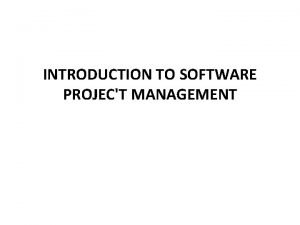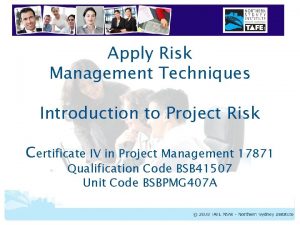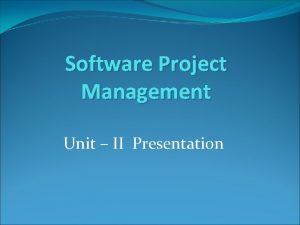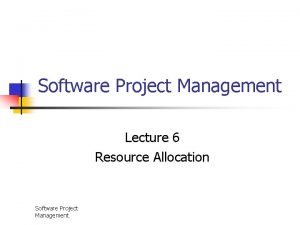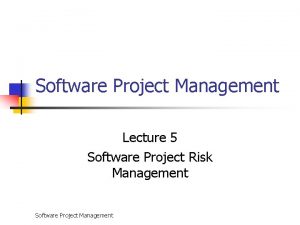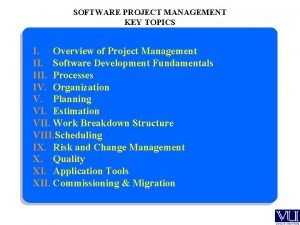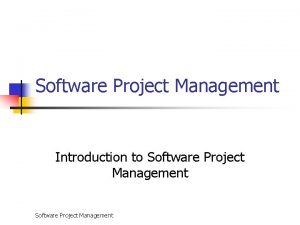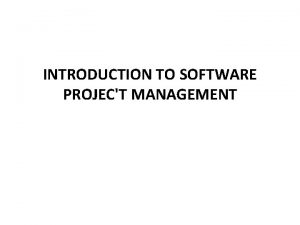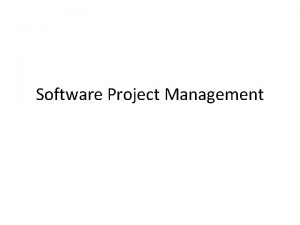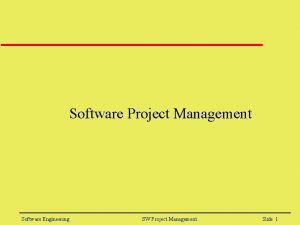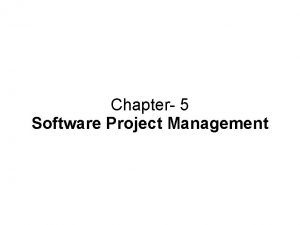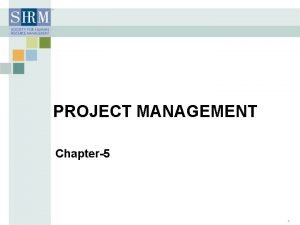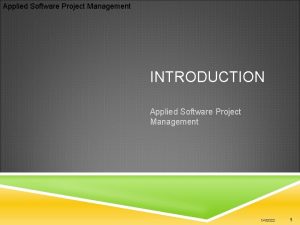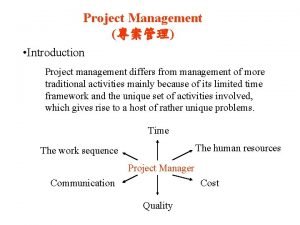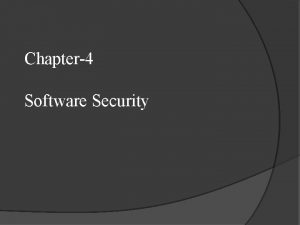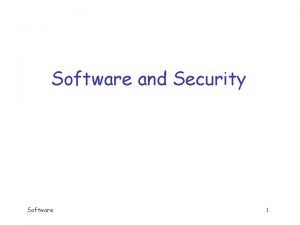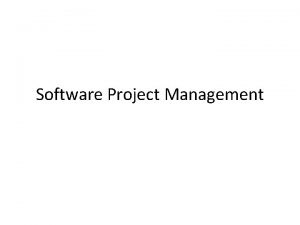INTRODUCTION TO SOFTWARE PROJECT MANAGEMENT Why is Software





















- Slides: 21

INTRODUCTION TO SOFTWARE PROJEC'T MANAGEMENT

Why is Software Project Management Important? • First, there is the question of money. A lot of money is at stake with Information and Communications Technology (ICT) projects. In the United Kingdom during the financial year 2002 -2003, the central government spent more on contracts for ICT projects – about £ 2. 3 billion • Unfortunately, projects are not always successful. In a report published in 2003, the Standish Group in the United States analyzed 13, 522 projects and concluded that only a third of projects were successful • The reason for these project shortcomings is often the management of projects

What is a project? • The following characteristics distinguish projects : – – – – – Non-routine tasks are involved; planning is required; specific objectives are to be met or specified product is to be created the project has pre-determined time span; work is carried out for someone other than yourself; work involves several specialisms; people are formed into a temporary workgroup to carry out the task; work is carried out in several Phases; the resources that are available for use on the project are constrained; The project is large or complex.

EXERCISE Consider the following: – Producing an edition of a newspaper; – Putting a robot vehicle on Mars to search for signs of life; – Getting married; Some seem more like real projects than others. Put them into an order most closely matching your ideas of what constitutes a project. For each entry in the ordered list, describe the difference between it and the one above which makes it less worthy of the term 'project'.

Software Projects versus Other Types of Project • Fred Brooks identified some characteristics of software projects which make them particularly difficult: – Invisibility: When a physical artefact such as a bridge is constructed the progress can actually be seen. With software, progress is not immediately visible. – Conformity: Software developers have to conform to the requirements of human clients. – Flexibility: it is expected that the software will change to accommodate the other components rather than vice versa. Thus software systems are particularly subject to change.

Contract Management and Technical Project Management • When organizations contract out ICT development to outside developers. The client organization will often appoint a 'project manager' to supervise the contract. • Thus, this project manager will not worry about estimating the effort needed to write individual software components as long as the overall project is within budget and on time. • On the supplier side, there will need to be project managers who deal with the more technical issues.

Activities Covered by Software Project Management • Usually there are three successive processes that bring a new system into being: 1. The feasibility study assesses whether a project is worth starting - that it has a valid business case. – The developmental and operational costs, and the value of the benefits of the new system, will also have to be estimated. 2. Planning If the feasibility study indicates that the prospective project appears viable, then project planning can start. 3. Project execution The project can now be executed.

Processes That Bring a New System Into Being

Figure 1. 3 shows the typical sequence of software development activities recommended in the international standard ISO 12207.

Software Development Activities in ISO 12207. • Requirements analysis: starts with requirements elicitation or requirements gathering which establishes what the potential users and their managers require of the new system. • Architecture design: The components of the new system that fulfill each requirement have to be identified. These components are not only software; they could be new hardware or work processes. • Detailed design: Each software component is made up of a number of software units that can be separately coded and tested. The detailed design of these units is carried out separately.

Software Development Activities in ISO 12207 • Code and test: refers to writing code for each software unit and Initial testing to debug individual software units. • Integration: The components are tested together to see if they meet the overall requirements. • Qualification testing: The system, including the software components, has to be tested carefully to ensure that all the requirements have been fulfilled. • Installation: This is the process of making the new system operational. • Acceptance support: This is the resolving of problems with the newly installed system Including maintenance and enhancement.

Stakeholders • These are people who have interest in the project. • Stakeholders can be categorized as: – Internal to the project team: This means that they will be under the direct managerial control of the project leader. – External to the project team but within the same organization: For example, the project leader might need the assistance of the users to carry out systems testing. – External to both the project team and the organization: may be customers (or users) who will benefit from the system that the project implements.

Setting Objectives • Among all these stakeholders are those who actually own the project. They set the objectives of the project. • The objectives should define what the project team must achieve for project success. • Objectives focus on the desired outcomes of the project rather than the tasks within it - they are the 'postconditions' of the project. • Informally the objectives could be written as a set of statements following the opening words 'the project will be a success if. . ' – 'customers can order our products online' rather than 'to build an e-commerce website'.

Sub-objectives and goals • In order to achieve the objective we must achieve certain goals or sub-objectives first. • These are steps on the way to achieving an objective, just as goals scored in a football match are steps towards the objective of winning the match. • Informally this can be expressed as a set of statements following the words 'To reach objective. . . , the following must be in place. . . '.

Objectives Should Be (SMART) • S->Specific: effective objectives are concrete and well defined. Objectives should be defined so that it is obvious to all whether the project has been successful • M->Measurable: Ideally there should be measures of effectiveness which tell us how successful the project has been. • A->Achievable: It must be within the power of the individual or group to achieve the objective. • R->Relevant: The objective must be relevant to the true purpose of the project. • T->Time constrained: There should be a defined point in time by which the objective should have been achieved.

The Business Case • Most projects need to have a justification or business case: • The effort and expense of the project must be worthwhile in terms of the benefits(benefits outweigh costs). • A cost-benefit analysis will often be part of the project's feasibility study. • The quantification of benefits will often require the formulation of a business model which explains how the new application can generate the claimed benefits.

The Business Case • A simple example of a business model is that a new web-based application might allow customers from all over the world to order a products via the internet, increasing sales and thus increasing revenue and profits. • Any project plan must ensure that the business case is kept intact. For example: – That development costs are not allowed to rise to a level which threatens to exceed the value of benefits; – That the features of the system are not reduced to a level where the expected benefits cannot be realized; – That the delivery date is not delayed so that there is an unacceptable loss of benefits.

What is Management? Management involves the following activities: – – – – Planning - deciding what is to be done; Organizing- making arrangements; Staffing - selecting the right people for the job; Directing - giving instructions; Monitoring - checking on progress; Controlling - taking action to remedy hold-ups; Innovating- coming up with new solutions Representing - liaising with clients, users, developer, suppliers and other stakeholders. • Much of the project manager's time is spent on only three of the eight activities: project planning, monitoring, and control.

Management Control Give an example for Appling each project control cycle phase on the following project: An ICT project is to replace locally held paper-based records with a centrally organized database. Staff in a large number of offices that are geographically dispersed need training and will then have to use the new ICT system to set up the manual records on the new database. The system cannot be properly operational until the last record has been transferred. The new system will only be successful if new transactions can be processed within certain time cycles.

Management Control • Data 'location X has processed 2000 documents' • Information(transform raw data into useful and meaningful data) 'percentage of records processed', 'average documents processed per day person' and 'estimated completion date'. • Comparison with objectives/goals: e. g. we should meet target of processing all documents by 31 st March • Making decisions/plans Comparing 'estimated completion date‘ with ‘completion date‘ In project objectives. if one or two branches will fail to complete the transfer of details in time then move staff temporarily from one branch to another.

Management Control • Modeling the date for the branch from which staff are being moved is pushed forward beyond that date. The project manager would need to calculate carefully what the impact would be in moving staff from particular branches. (This is modeling the consequences of a potential solution). • Implementation Chose one of modeled solutions and implement it.
 Hey bye bye
Hey bye bye Modern process transitions in spm
Modern process transitions in spm Project evaluation in software project management
Project evaluation in software project management Software
Software Importance of software project management
Importance of software project management Improvement of software economics
Improvement of software economics Configuration item definition
Configuration item definition Don't ask why why why
Don't ask why why why Integrating metrics within the software process
Integrating metrics within the software process The role of project management in achieving project success
The role of project management in achieving project success Project cost-duration graph
Project cost-duration graph Modern project management began with what project
Modern project management began with what project When conducting post project audits
When conducting post project audits Microsoft project scrum template
Microsoft project scrum template Type n terminations
Type n terminations Class diagram gym management system
Class diagram gym management system Introduction to project risk management
Introduction to project risk management Effective software project management
Effective software project management Cash flow forecasting in software project management
Cash flow forecasting in software project management Resource requirements example
Resource requirements example What is risk in software project management
What is risk in software project management Software project management topics
Software project management topics



